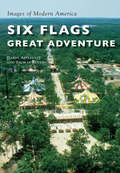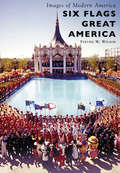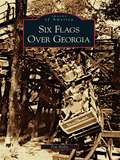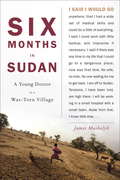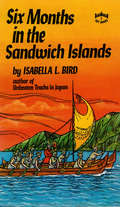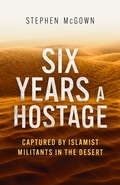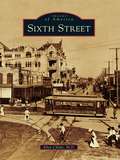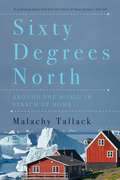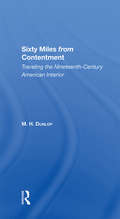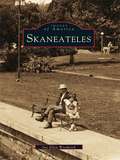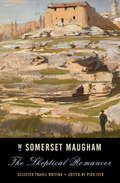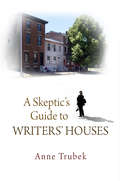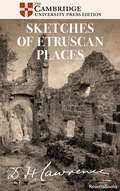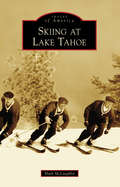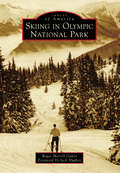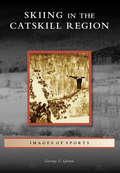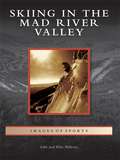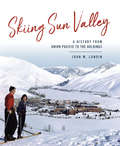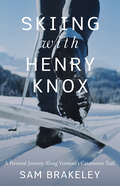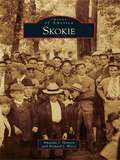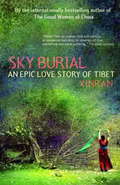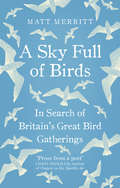- Table View
- List View
Six Flags Great Adventure (Images of Modern America)
by Thomas Benton Harry ApplegateBuilt in 1974, Great Adventure was the larger-than-life dream of a larger-than-life personality, Warner LeRoy. The consummate showman, LeRoy had visions of a fantasy world of rides, shows, and animals in a beautiful and unspoiled woodland setting. In 1977, Great Adventure became a member of the Six Flags family of theme parks and has continued to grow ever since, with bigger and better attractions added each season. Six Flags Great Adventure revisits some of the park's past attractions, like the Garden of Marvels, Big Balloon, and Super Teepee, and illustrates the park's evolution into a state-of-the-art theme park enjoyed by a new generation of guests.
Six Flags Great America (Images of Modern America)
by Steven W. WilsonMarriott’s Great America first opened in Gurnee, Illinois, on May 29, 1976. Located midway between Chicago and Milwaukee, it was the second of two Marriott Corporation theme parks. Great America was created to be a place where families could have fun together while gaining an appreciation for United States history. The park’s five authentically themed areas based on America’s past included the best in family and thrill rides, restaurants, specialty shops, artisans, and games. First-rate live entertainment included Broadway-style musicals, bands, parades, a circus, and the Warner Bros. characters featuring BUGS BUNNY. In 1984, the park became Six Flags Great America when it joined the Six Flags family of theme parks. Since then, the park has continued to innovate and expand. Today, including its 20-acre Hurricane Harbor water park, Six Flags Great America is one of the country’s finest theme parks. Since 1976, the park has entertained more than 100 million guests.
Six Flags Over Georgia
by Tim HollisWhen Six Flags Over Georgia opened in June 1967, it became the first theme park in the Southeast. Although the park is best known today for its high-speed roller coasters, this book recaptures its earlier years when it was devoted to the various periods of Georgia's history. Six Flags Over Georgia revisits such classic rides and attractions as the Log Jamboree, Tales of the Okefenokee, Jean Ribaut'sAdventure, the Krofft Puppet Theater, the Happy Motoring Freeway, and many others. It also explores how the park's focus changed and expanded over the decades and takes a look at some of its classic advertising and souvenirs.
Six Months in Sudan: A Young Doctor in a War-Torn Village
by James MaskalykJames Maskalyk set out for the contested border town of Abyei, Sudan, in 2007. THe newest M_dicins Sans Fronti+res' doctor in the field, he arrived with only his training, full of desire to understand this most desperate part of the world. He returned home six months later profoundly affected by the experience. Six Months in Sudan is an illuminating and affecting account of saving lives in one of the most harrowing and dangerous places on Earth.
Six Months in the Sandwich Islands
by Isabella L. BirdThis classic of Hawaiian literature offers a charming glimpse at the splendid and fascinating world of pre-American Hawaii.Isabella Lucy Bird won fame in her own time as the most remarkable woman traveler of the nineteenth century, and Six Months in the Sandwich Isles, in which she describes her sojourn in Hawaii in 1873, is one of the gems of Pacific literature. It is safe to say that no other book about Hawaii surpasses it in fascination. Much of the charm of Isabella's writing is due to her use of personal letters for conveying her her experiences and her impressions. The thirty-one letters that compose the book were written to her beloved sister Henrietta, who dutifully stayed at home in Edinburgh to take care of the household while Isabella was away on her travels.The book is an authentic record of daily life in Hawaii in the late nineteenth century. It describes a life style during the brief reign of King Lunalilo, not too may years before the sad reign of Queen Liliuokalani ended her dethronement by revolution. Isabella Bird met royalty, missionaries, cowboys, and ordinary, everyday Hawaiians. It is fortunate that she left such a vivid narrative of her Hawaiian Interlude.
Six Months in the Sandwich Islands
by Isabella L. BirdThis classic of Hawaiian literature offers a charming glimpse at the splendid and fascinating world of pre-American Hawaii.Isabella Lucy Bird won fame in her own time as the most remarkable woman traveler of the nineteenth century, and Six Months in the Sandwich Isles, in which she describes her sojourn in Hawaii in 1873, is one of the gems of Pacific literature. It is safe to say that no other book about Hawaii surpasses it in fascination. Much of the charm of Isabella's writing is due to her use of personal letters for conveying her her experiences and her impressions. The thirty-one letters that compose the book were written to her beloved sister Henrietta, who dutifully stayed at home in Edinburgh to take care of the household while Isabella was away on her travels.The book is an authentic record of daily life in Hawaii in the late nineteenth century. It describes a life style during the brief reign of King Lunalilo, not too may years before the sad reign of Queen Liliuokalani ended her dethronement by revolution. Isabella Bird met royalty, missionaries, cowboys, and ordinary, everyday Hawaiians. It is fortunate that she left such a vivid narrative of her Hawaiian Interlude.
Six Years a Hostage: Captured by Islamist Militants in the Desert
by Stephen McGownStephen McGown was en route from London to South Africa, on a once-in-a-lifetime trip by motorbike, returning home to Johannesburg. He had reached Timbuktu, in Mali, when he was captured, along with a Dutch and a Swedish national, by Al Qaeda Islamist militants. Steve was taken because he held a British passport. He was subsequently held hostage at various camps in the Sahara Desert in the north-west of Africa for nearly six years before eventually being released.Life as Steve had known it changed in that instant that he was taken at gunpoint. He had nothing to bargain with, and everything to lose. For the next six years, he reluctantly engaged in what he came to call the greatest chess game of his life. Thousands of kilometres to the south, in Johannesburg, the shock of Stephen's capture struck the McGown family and his wife, Cath, with whom he had, until recently, been living in London. They immediately began efforts to secure Steve's release, through diplomatic channels and in every other way they felt might have a chance of seeing Stephen freed. But as the months of captivity became years, Steve was compelled to go to extraordinary lengths to survive. Making it back home alive became his sole aim. To accomplish this, he realised that he would have to do everything he could to raise his status in the eyes of his captors. To this end, he taught himself Arabic and French, and also converted to Islam, accepting a new name, Lot. To this day, Steve retains the unenviable record of being the longest-held, surviving prisoner of Al Qaeda. While he was undoubtedly always Al Qaeda's captive, through the long years he spent in intimate proximity to his captors, Steve got to see the Islamist militants as few other Westerners have ever seen them. Six Years a Hostage is not only a remarkable story of mental strength, physical endurance and the resilience of the human spirit, but also, significantly, a unique and nuanced perspective onone of the world's most feared terrorist groups. Steve did not merely survive his terrible ordeal; he emerged from the desert a changed - stronger, more positive - human being. This is Stephen McGown's remarkable story, as told to Tudor Caradoc-Davies, a freelance writer, editor and author based in Cape Town, South Africa. After seven years spent working for glossy magazines such as Men's Health, GQ, Best Life and Women's Health, he now contributes to a range of publications. He also writes for the (South African) Sunday Times, and Red Bulletin.
Six Years a Hostage: Captured by Islamist Militants in the Desert
by Stephen McGownStephen McGown was en route from London to South Africa, on a once-in-a-lifetime trip by motorbike, returning home to Johannesburg. He had reached Timbuktu, in Mali, when he was captured, along with a Dutch and a Swedish national, by Al Qaeda Islamist militants. Steve was taken because he held a British passport. He was subsequently held hostage at various camps in the Sahara Desert in the north-west of Africa for nearly six years before eventually being released.Life as Steve had known it changed in that instant that he was taken at gunpoint. He had nothing to bargain with, and everything to lose. For the next six years, he reluctantly engaged in what he came to call the greatest chess game of his life. Thousands of kilometres to the south, in Johannesburg, the shock of Stephen's capture struck the McGown family and his wife, Cath, with whom he had, until recently, been living in London. They immediately began efforts to secure Steve's release, through diplomatic channels and in every other way they felt might have a chance of seeing Stephen freed. But as the months of captivity became years, Steve was compelled to go to extraordinary lengths to survive. Making it back home alive became his sole aim. To accomplish this, he realised that he would have to do everything he could to raise his status in the eyes of his captors. To this end, he taught himself Arabic and French, and also converted to Islam, accepting a new name, Lot. To this day, Steve retains the unenviable record of being the longest-held, surviving prisoner of Al Qaeda. While he was undoubtedly always Al Qaeda's captive, through the long years he spent in intimate proximity to his captors, Steve got to see the Islamist militants as few other Westerners have ever seen them. Six Years a Hostage is not only a remarkable story of mental strength, physical endurance and the resilience of the human spirit, but also, significantly, a unique and nuanced perspective onone of the world's most feared terrorist groups. Steve did not merely survive his terrible ordeal; he emerged from the desert a changed - stronger, more positive - human being. This is Stephen McGown's remarkable story, as told to Tudor Caradoc-Davies, a freelance writer, editor and author based in Cape Town, South Africa. After seven years spent working for glossy magazines such as Men's Health, GQ, Best Life and Women's Health, he now contributes to a range of publications. He also writes for the (South African) Sunday Times, and Red Bulletin.
Sixth Street
by Allen ChildsNow listed in the National Register of Historic Places, Sixth Street began more than 170 years ago as the only level pathway into the town of Austin from the east. Originally called Pecan Street, throughout its history the street was also a level playing field for merchants and minorities, for moneyed dynasties and little mom-and-pop places. When Austin was a segregated society, Sixth Street was a standout exception where people of all races lived and worked. By 1871, the arrival of the railroad kindled the explosive development of Pecan Street into Austin's first mercantile center. It was home to Austin's first hotel, Bullock's at Congress Avenue and Pecan Street; the first fight with the government of the new Republic of Texas; and the first brothel. In the 1970s, the commercial district suffered some deterioration. Then, as it has done before, Sixth Street was reborn, this time as the Sixth Street Historic Entertainment District. Loved by Austin residents and visitors alike, Sixth Street is Texas's most famous thoroughfare.
Sixty Degrees North: Around the World in Search of Home
by Malachy TallackFrom the northern wilds of Greenland and Scotland to the far away reaches of Scandinavia and Siberia, a moving meditation on the allure of travel and the meaning of home. The sixtieth parallel marks a borderland between the northern and southern worlds. Wrapping itself around the lower reaches of Finland, Sweden, and Norway, it crosses the tip of Greenland and the southern coast of Alaska, and slices the great expanses of Russia and Canada in half. The parallel also passes through Shetland, where Malachy Tallack has spent most of his life. In Sixty Degrees North, Tallack travels westward, exploring the landscapes of the parallel and the ways that people have interacted with those landscapes, highlighting themes of wildness and community, isolation and engagement, exile and memory. An intimate journey of the heart and mind, Sixty Degrees North begins with the author's loss of his father and his own troubled relationship with Shetland, and concludes with an embrace of the place he calls home.
Sixty Miles From Contentment: Traveling The Nineteenth-Century American Interior
by M. H. DunlopSixty Miles from Contentment is a revitalization of a pulsating American scene in the nineteenth-century. Drawing on the work of travel writers from America's own East Coast and from fourteen other countries, it offers a witty and irreverent look at the wild Midwest in its heyday.
Skaneateles
by Sue Ellen WoodcockIt is known as one of the most beautiful and cleanest lakes around, and for years Skaneateles Lake and the town of Skaneateles have served as the eastern gateway to the Finger Lakes, drawing visitors from all over the world. The beauty of the lake is enhanced by the well-kept village and town, which line its shores. Many of the early homes and buildings have been well maintained and are recognizable today. From the mid-1800s to the 1970s, the town changed little from when it was first settled in 1794.With sailboats and steamships, old views of the village and of school days of yore, Skaneateles recalls the people, places, and events that made a difference. Included are people such as John D. Barrow and Clarence Austin, places such as the Glen Haven Water Cure and the Packwood House, and events such as Bobby Kennedy's visit and Microd racing. Skaneateles also recalls the City of Syracuse and the town's great history of steamships, sailing and boating, and early industries.
The Skeptical Romancer
by W. Somerset MaughamW. Somerset Maugham was one of the seminal writers of the twentieth century, and his travel writing has long been considered among his finest work. Now, acclaimed travel writer Pico Iyer maps out a masterful tour of these vivid, evocative pieces that are collected here for the first time.Maugham worked as a secret agent in Russia, published novels in London, staged plays in New York, and traveled throughout Europe, Asia, India, and the United States, chronicling his travels, wherever he went, with exceptional insight. Beginning with "In the Land of the Blessed Virgin" and culminating in "A Partial View," Iyer selects vignettes of Maugham's razor-sharp prose that track his transformation from a boyish traveler in Spain to a worldly man of letters.This is Maugham at his most keenly observant, direct, and powerful.From the Hardcover edition.
A Skeptic's Guide to Writers' Houses
by Anne TrubekThere are many ways to show our devotion to an author besides reading his or her works. Graves make for popular pilgrimage sites, but far more popular are writers' house museums. What is it we hope to accomplish by trekking to the home of a dead author? We may go in search of the point of inspiration, eager to stand on the very spot where our favorite literary characters first came to life--and find ourselves instead in the house where the author himself was conceived, or where she drew her last breath. Perhaps it is a place through which our writer passed only briefly, or maybe it really was a longtime home--now thoroughly remade as a decorator's show-house.In A Skeptic's Guide to Writers' Houses Anne Trubek takes a vexed, often funny, and always thoughtful tour of a goodly number of house museums across the nation. In Key West she visits the shamelessly ersatz shrine to a hard-living Ernest Hemingway, while meditating on his lost Cuban farm and the sterile Idaho house in which he committed suicide. In Hannibal, Missouri, she walks the fuzzy line between fact and fiction, as she visits the home of the young Samuel Clemens--and the purported haunts of Tom Sawyer, Becky Thatcher, and Injun' Joe. She hits literary pay-dirt in Concord, Massachusetts, the nineteenth-century mecca that gave home to Hawthorne, Emerson, and Thoreau--and yet could not accommodate a surprisingly complex Louisa May Alcott. She takes us along the trail of residences that Edgar Allan Poe left behind in the wake of his many failures and to the burned-out shell of a California house with which Jack London staked his claim on posterity. In Dayton, Ohio, a charismatic guide brings Paul Laurence Dunbar to compelling life for those few visitors willing to listen; in Cleveland, Trubek finds a moving remembrance of Charles Chesnutt in a house that no longer stands.Why is it that we visit writers' houses? Although admittedly skeptical about the stories these buildings tell us about their former inhabitants, Anne Trubek carries us along as she falls at least a little bit in love with each stop on her itinerary and finds in each some truth about literature, history, and contemporary America.
Sketches of Etruscan Places (Penguin Twentieth Century Classics Ser.)
by D.H. LawrenceFrom the author of The Rainbow, a travelogue of his journey through central Italy during the reign of Mussolini. Written in 1927 after visiting several Etruscan cities in central Italy, six of the seven essays contained in Sketches of Etruscan Places were posthumously published in 1932. The seventh, &“The Florence Museum&” is published here for the first time, along with forty-five illustrations reproduced with D. H. Lawrence&’s own captions. The second part of this volume contains eight additional essays about Florence and the Tuscan countryside.
Skiing at Lake Tahoe (Images of America)
by Mark MclaughlinOrganized ski racing in America started near Lake Tahoe in the 1860s when gold miners rode 15-foot boards that reached speeds near 100 miles per hour. By 1895, residents of Truckee had started the nation's first winter carnival west of the Rocky Mountains and soon built the largest ski jump in California. Today's Lake Tahoe, with significant annual snowfall, has become home to the largest concentration of ski resorts on the continent. Places like Mount Rose, Squaw Valley (home of the 1960 Winter Olympics), Sugar Bowl, Heavenly Valley, Homewood, Sierra-at-Tahoe, Alpine Meadows, Kirkwood, Diamond Peak, Donner Ski Ranch, Granlibakken, and Northstar-at-Tahoe have seen skiing styles, sports, and fashions churn through the decades, while now gone resorts, such as Edelweiss and White Hills Ski Resort, echo the memories of yesterday's skiers through the pines.
Skiing in Olympic National Park
by Roger Merrill OakesWith its glaciated peaks, temperate rain forests, and ocean wilderness, Olympic National Park has been called three parks in one. Efforts to protect and preserve these treasures began with the creation of a federal reserve in 1897, followed by a national monument in 1909, and then Olympic National Park in 1938. The 1920s and 1930s saw the building of many trails, shelters, and roads. In 1934, the US Forest Service completed a primitive road to the summit of Blue Mountain, affording skiing at Deer Park, and in 1957, the National Park Service completed an improved road to Hurricane Ridge. These two areas have offered alpine (lift-assisted) skiing to several generations. While these roads remain today, the recognition of the value of preserved wilderness has stopped road construction. In 1988, most of the park became federally designated wilderness. In 1981, Olympic National Park was designated a World Heritage Site.
Skiing in the Catskill Region (Images of Sports)
by George V. QuinnArriving by train to Phoenicia, New York, in the mid-1930s, downhill skiers first discovered the snowy trails of Simpson Ski Slope. Soon after, many Borscht Belt hotels were offering skiing and skating as ways to fill rooms during cold winter months when crowds thinned. In the high central Catskills, where abundant snowfall was a big draw, many abandoned rooming houses were commandeered to serve as base lodges for fledgling ski areas. In addition to farming and logging, skiing became an important industry to the area. People found steady employment in dozens of new areas sprouting all over the mountains. Downhill skiing is just part of the region's history. Ski jumping, racing, ski clubs, fashion, and colorful personalities were all part of the experience.
Skiing in the Mad River Valley
by Ellie Hilferty John HilfertyIn 1948, the first skiers to experience the steep and twisting downhill trails of Mad River Glen had to traverse muddy or frozen dirt roads to get to their destination. The warmth of a country inn was a comfort on those cold winter nights and continues as a hallmark of the Mad River Valley today. Even with the condo boom that developed after the opening of Sugarbush on Christmas Day in 1958, little has upset the ambience of the 20-mile-long valley. The valley developed a distinct personality, attracting "ski bums" who exchanged urban pressures for a laid-back lifestyle that continues today.
Skiing Sun Valley: A History from Union Pacific to the Holdings (Sports)
by John W. LundinUnion Pacific Railroad's Averell Harriman had a bold vision to restore rail passenger traffic decimated by the Great Depression: create ski tourism in Idaho's remote Wood River Valley. A $1.5 million investment opened Sun Valley in December 1936 with a lavish lodge, luxury shopping, Austrian ski instructors and extensive backcountry skiing. Prestigious tournaments featured the world's best skiers. Chairlifts invented by Union Pacific engineers serviced skiers quickly and comfortably. Ski instructor and filmmaker Otto Lang recalled that seemingly overnight, it became "a magnet for the 'beautiful people,' a meeting place for movie stars and moguls, chairmen and captains of industry, Greek shipping tycoons, and peripatetic playboys--and playgirls--of the international social set." After World War II and Harriman's departure, Union Pacific's willingness to pay the $500,000 yearly subsidy waned. Bill Janss purchased it in 1964 and reimagined it as a year-round resort but lacked the capital for growth. Sinclair Oil owners Earl and Carol Holding acquired it in 1977, revitalizing it into a premier resort with international status. Award-winning ski historian John W. Lundin celebrates America's first destination ski resort using unpublished Union Pacific documents, oral histories, contemporaneous accounts and more than 150 historic images.
Skiing with Henry Knox: A Personal Journey Along Vermont’s Catamount Trail
by Sam BrakeleyIn 2015, Sam Brakeley stood at a crossroads in his life. His long-time girlfriend was moving to Utah, with or without him, and he was torn between following her or remaining in New England with family, friends, and the land he loved. So he set out to complete the Catamount Trail, a 330-mile cross-country ski trail that runs across Vermont from the Massachusetts border to Canada. He took advantage of his time in the woods to reach a decision—and brought Henry Knox along for the trip. In 1775, Knox undertook a winter journey of similar length, retrieving dozens of artillery pieces from the recently captured Fort Ticonderoga on Lake Champlain and dragging them 300 miles through snow and cold to Cambridge, Massachusetts, to help George Washington drive the entrenched British army from Boston. Knox, too, faced his own challenges in love, leaving behind a young pregnant wife. By exploring Knox’s eighteenth-century physical and emotional journey while undertaking his own twenty-first-century trip on the Catamount Trail, Brakeley reminds us that history has many lessons to offer the living.
Skin City: Behind the Scenes of the Las Vegas Sex Industry
by Jack SheehanPart exposé, part x-rated travel guide -- the ultimate insider's look at America's adult playgroundVegas. It's a place where Midwestern couples become uninhibited swingers, where shy schoolgirls morph into sexy strippers pulling in $1,000 a night, and where randy tourists come to score at more than just blackjack and craps. What happens here, stays here -- and Vegas nightlife is hotter than it's ever been before.In Skin City, journalist and longtime Vegas resident Jack Sheehan goes beyond the bright lights to explore the dark thrills of the city's sex industry. Both lurid and fascinating, here is an unabashed look at the stripping, swinging, hustling, and hooking that have turned a desert gaming metropolis into the world's capital of lascivious entertainment. But more than a no-holds-barred exposé, Sheehan's Skin City offers a connoisseur's catalogue of where to go for readers whose tastes run to the erotic -- with everything from valuable pointers from lap dancers, call girls, and vice cops to porn star Jenna Jameson's list of her favorite Vegas strip clubs.
Skokie (Images of America)
by Amanda J. Hanson Richard J. WitrySettled in the late 1840s and incorporated as Niles Centre in 1888, Skokie was founded by immigrants from Germany and Luxembourg who created a small-town rural community filled with farms and greenhouses. A short-lived real estate boom in the 1920s gave Skokie its current boundaries, streets, and sewer systems. Due to the Great Depression, however, these paved roadways remained vacant until after World War II. Aided by the construction of the Edens Expressway, Skokie experienced tremendous growth and became a bustling suburban community. Many of the families that settled in Skokie during this time were Jewish. In the last quarter century, other families moved to the suburb, many with Indo-Asian origins, leading to the ethnically diverse community that Skokie has become today.
Sky Burial
by XinranIn 2002 Xinran's Good Women of China became an international bestseller, revealing startling new truths about Chinese life to the West. Now she returns with an epic story of love, friendship, courage and sacrifice set in Chinese-occupied Tibet. Based on a true story, Xinran's extraordinary second book takes the reader right to the hidden heart of one of the world's most mysterious and inaccessible countries. In March 1958, Shu Wen learns that her husband, an idealistic army doctor, has died while serving in Tibet. Determined to find out what happened to him, she courageously sets off to join his regiment. But to her horror, instead of finding a Tibetan people happily welcoming their Chinese "liberators" as she expected, she walks into a bloody conflict, with the Chinese subject to terrifying attacks from Tibetan guerrillas. It seems that her husband may have died as a result of this clash of cultures, this disastrous misunderstanding. But before she can know his fate, she is taken hostage and embarks on a life-changing journey through the Tibetan countryside -- a journey that will last twenty years and lead her to a deep appreciation of Tibet in all its beauty and brutality. Sadly, when she finally discovers the truth about her husband, she must carry her knowledge back to a China that, in her absence, has experienced the Cultural Revolution and changed beyond recognition. . .
A Sky Full of Birds
by Matt Merritt'Prose from a poet and a personal take on the spectacles' Chris Packham, author of Fingers in the Sparkle JarShortlisted for Richard Jefferies Society & White Horse Bookshop Literary Prize 2017Longlisted for the Wainwright Prize 2017Britain is a nation of bird-lovers. However, few of us fully appreciate the sheer scale, variety and drama of our avian life. From city-centre hunters to vast flocks straight out of the Arctic wilderness, much-loved dawn songsters to the exotic invaders of supermarket car parks, a host of remarkable wildlife spectacles are waiting to be discovered right outside our front doors.In A Sky Full of Birds, poet and nature writer Matt Merritt shares his passion for birdwatching by taking us to some of the great avian gatherings that occur around the British isles – from ravens in Anglesey and raptors on the Wirral, to Kent nightingales and Scottish capercaillies. By turns lyrical, informative and entertaining, he shows how natural miracles can be found all around us, if only we know where to look for them.A Sky Full of Birds is the perfect read for avid birdwatchers and a beautiful gift for lovers of nature and poetic prose.
